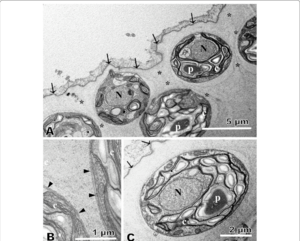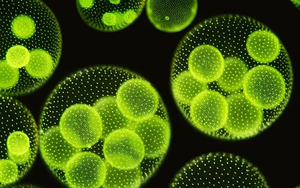Volvox africanus



Classification
Eukarya; Chlorophyta; Chlorophyceae; Chlamydomonadales; Volvocaceae
Species
Volvox africanus
NCBI: [1]
Description and Significance
Volvox africanus is a photosynthetic, multicellular eukaryotic microbe that lives in clusters. Volvox species exist as many cell colonies within a gelatinous barrier. They contain anywhere from several hundred to 6,000 cells within their gelatin bubble. In fact, the largest clusters are barely visible with the naked eye.
Volvox is a freshwater algal genus that was first discovered by Anton von Leeuwenhook in the 1700s. They have fascinating reproductive cycles consisting of both sexual and asexual reproduction.
Genome Structure
Volvox africanus has a haploid, linear genome, with between 129-142 megabases (mb). The National Center for Biotechnology Information (NCBI) holds two full genomic sequences of this species. One sequence discovered about 13,455 protein coding genes, 129 contigs, and that 53% of the genome is comprised of GC nucleotides. The other sequence resulted in different data. It matched the first with the genome containing 53% of GC nucleotides, however, it found 12,742 protein coding genes and 448 contigs.
Cell Structure, Metabolism, and Life Cycle
Volvox shape is complex to describe due to the vast number of cells within their gelatinous barrier. The best way to describe it is a bunch of cocci unicellular organisms living within a spheritical gel-like substance. Each of cocci cells, called somatic cells, work together to survive. They have flagellum, eyespots, and vacuoles. The somatic cells move their flagellum in tandom for fast, coordinated directional movements.
It reproduces both asexually and sexually.
Ecology and Pathogenesis
Live in freshwaters sources, and like most algal species, rely on photosynthesis for nutrients and energy. As a result, they are valuable for consuming carbon dioxide and releasing oxygen for aerobic organisms. Somatic cells contain one chloroplast each.
Typically found in South Africa, other southern african countries, and south Asia.
All discovered Volvox species are non-pathogenic.
References
https://en.wikipedia.org/wiki/Volvox https://utex.org/products/utex-lb-1890 https://www.ncbi.nlm.nih.gov/Taxonomy/Browser/wwwtax.cgi?id=51714 https://eol.org/pages/901574 https://www.algaebase.org/search/species/detail/?species_id=C60a996d47989b5be https://www.researchgate.net/figure/Transmission-electron-microscopy-of-asexual-spheroids-of-Volvox-africanus-GS-West_fig3_358009972 https://www.britannica.com/science/green-algae
Authors
Page authored by Hayden Hull, student of Professor Bradley Tolar at UNC Wilmington.
